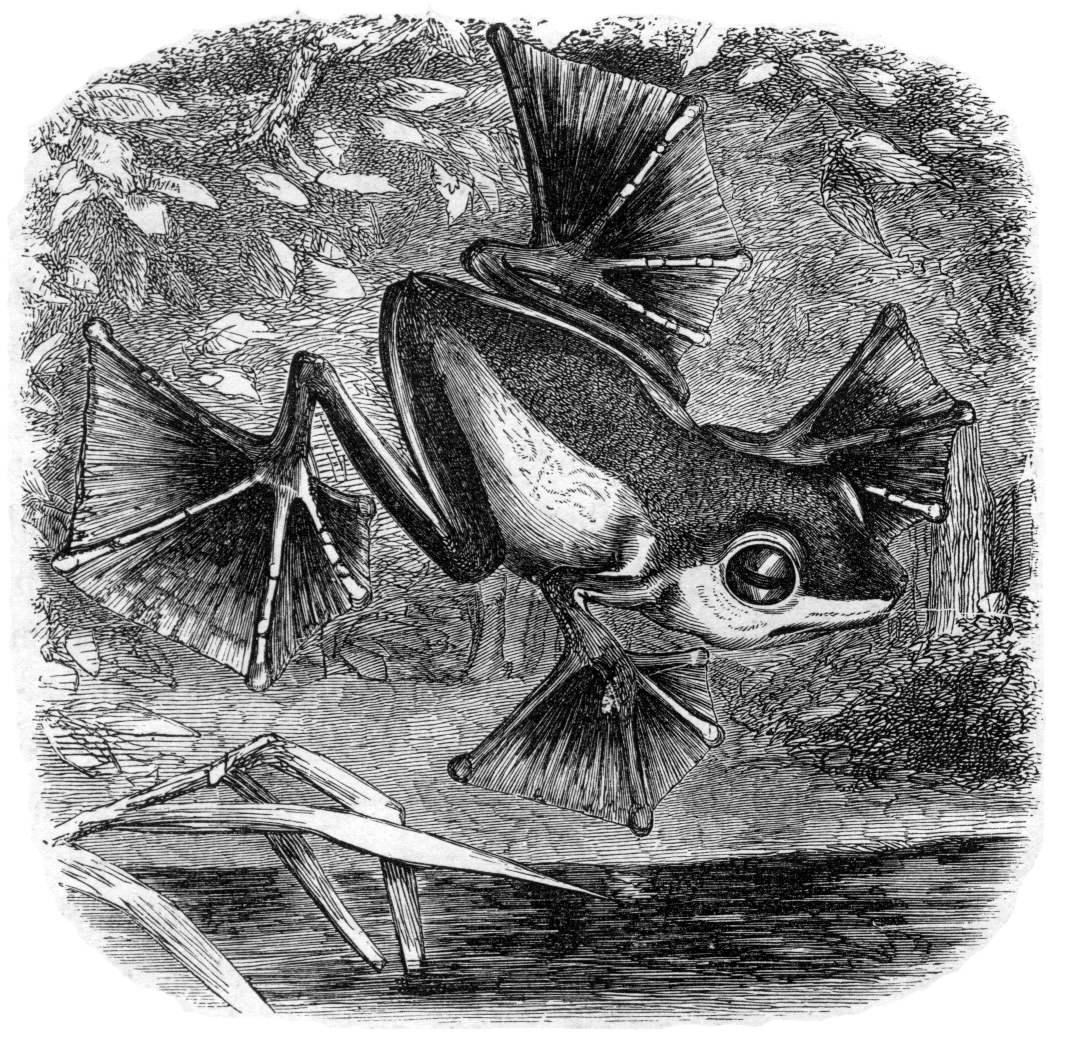- Rhacophorus nigropalmatus
__NOTOC__Taxobox
name = Wallace's Flying Frog

image_width = 220px
image_caption = Illustration from Wallace's, "The Malay Archipelago "
status = LC
status_system = iucn3.1
regnum =Animal ia
phylum =Chordata
subphylum =Vertebrata
classis =Amphibia
subclassis =Lissamphibia
ordo =Anura
subordo =Neobatrachia
familia =Rhacophoridae
subfamilia =Rhacophorinae
genus = "Rhacophorus "
species = "R. nigropalmatus"
binomial = "Rhacophorus nigropalmatus"
binomial_authority =Boulenger , 1895The
species "Rhacophorus nigropalmatus", commonly known as Wallace's Flying Frog, is amoss frog found at least from toMalay Peninsula into westernIndonesia . It is named for the biologist, Alfred R. Wallace, who collected the first specimen to be formally identified."R. dennysii", "R. maximus" and "Polypedates feae" were once contained within Wallace's Fyling Frog as
subspecies . Similar frogs also occur inLaos ,Vietnam and southernChina ; these may be "R. nigropalmatus" or an undescribed closely related species.van Dijk "et al." (2004)]Description [Tunstall (2003), Bordoloi "et al." (2007)]
This frog is quite
photogenic , due to its large size, brilliant colors, and interesting behavior [Sukumaran (2005)] . With a body length of 80-100 mm (males are smaller than females), it is one of the largest species of "Rhacophorus ". Its eyes andeardrum are large, its limbs are very long, and its fingers and toes are webbed right to the tips. Together with a fringe of skin stretching between the limbs, thisflying frog can parachute to the forest floor from high up in the trees where it is normally found.Its back is bright shiny green and the underside is white to pale yellow. The upperside of the inside toes as well as the outer part of the toe and finger webbing is brilliant yellow. The base of the webs as well as one flank spot per side are jet black. Overall, this frog looks much like the
Green Flying Frog ("R. reinwardtii") or "R. kio", which even if full grown do not reach the size of Wallace's Flying Frog however, and have the fringe of the webs more orange.This species' verified range extends from
Ranong south toEndau andRompin on theMalay Peninsula ; in theIndonesia narchipelago it is found onBorneo andSumatra . It is a lowland species, occurrring up to 600 meters ASL.It is most frequently found in
tropical and perhaps (to the north of its known range)subtropical primaryrainforest , but will also inhabit oldsecondary forest and overgrown fields. It avoids open areas and low growth, depending on a mixed growth containing trees of several meters height. Usually it is not often encountered, preferring a life up in the treetops. In breeding season hovever, these frogs descend to pools on the forest floor, often in considerable numbers. As usual for moss frogs, its eggs are attached to shrubs overhanging such pools and puddles, from where thetadpole s drop down into the water after hatching.Due to its wide range, Wallace's Flying Frog is not considered threatened by the
IUCN .Footnotes
References
* (2007): Systematics of the genus "Rhacophorus" (Amphibia, Anura): identity of red-webbed forms and description of a new species from Assam. "
Zootaxa " 1653: 1–20. [http://www.mapress.com/zootaxa/2007f/z01653p020f.pdf PDF abstract and first page]
* (2005): [http://frogweb.org/Articles.aspx?ArticleID=10 Encounter with Wallace's Flying Frog, The Frog of the Monsoons] . Version of 2005-JUN-29. Retrieved 2007-JUN-22.
* (2003): AmphibiaWeb - [http://amphibiaweb.org/cgi/amphib_query?query_src=aw_search_index&max=200&where-genus=Rhacophorus&where-species=nigropalmatus "Rhacophorus nigropalmatus", Wallace's Flying Frog] . Version of 2003-APR-12. Retrieved 2007-JUN-22.
*|year=2004|id= 59008|title=Rhacophorus nigropalmatus|downloaded=22 June 2007ee also
*
Flying frog
Wikimedia Foundation. 2010.
